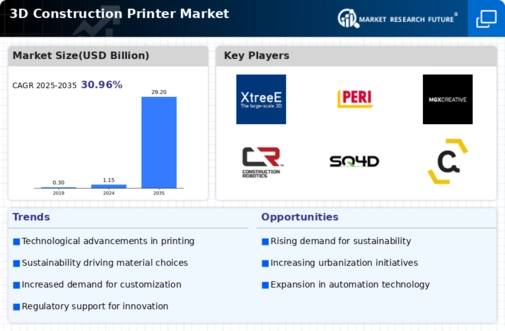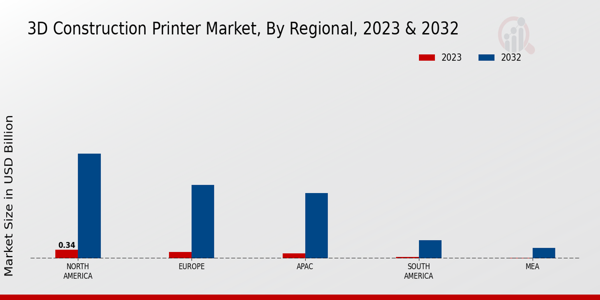Cost Efficiency
Cost efficiency is a crucial factor propelling the Global 3D Construction Printer Market Industry. The ability to reduce material waste and streamline construction processes translates into significant cost savings for builders. 3D printing can lower labor costs and minimize the time required for project completion, which is particularly appealing in a competitive market. As the technology matures, the cost of 3D printers is expected to decrease, making them more accessible to a broader range of construction firms. This potential for enhanced cost efficiency is likely to attract more investments into the sector, contributing to the market's anticipated growth.
Labor Shortages
The Global 3D Construction Printer Market Industry is also influenced by ongoing labor shortages in the construction sector. As skilled labor becomes increasingly scarce, 3D printing offers a viable solution by minimizing the need for manual labor in construction processes. Automated printing technologies can operate with fewer personnel, thereby addressing labor challenges while maintaining productivity. This trend is particularly relevant in regions experiencing significant construction activity, where the demand for skilled workers exceeds supply. Consequently, the adoption of 3D printing technologies is likely to rise, further driving market growth.
Market Growth Projections
The Global 3D Construction Printer Market Industry is projected to experience substantial growth, with estimates indicating a rise from 1.15 USD Billion in 2024 to 29.2 USD Billion by 2035. This growth trajectory suggests a compound annual growth rate (CAGR) of 34.2% from 2025 to 2035. Such projections reflect the increasing adoption of 3D printing technologies in construction, driven by factors such as technological advancements, sustainability initiatives, and labor shortages. The market's expansion is likely to attract significant investments, further enhancing its development and integration into the global construction landscape.
Sustainability Initiatives
Sustainability is a driving force in the Global 3D Construction Printer Market Industry, as the construction sector seeks to reduce its environmental footprint. 3D printing technologies utilize fewer materials and generate less waste compared to traditional construction methods. Additionally, the ability to use recycled materials in the printing process aligns with global sustainability goals. Governments and organizations are increasingly advocating for sustainable practices, which may lead to regulatory support for 3D printing in construction. This shift towards eco-friendly construction methods is anticipated to enhance market growth, particularly as the industry aims for a more sustainable future.
Technological Advancements
The Global 3D Construction Printer Market Industry is propelled by rapid technological advancements in printing materials and methods. Innovations such as the development of high-strength concrete and bio-based materials enhance the capabilities of 3D printers, allowing for more complex designs and structures. For instance, the introduction of robotic arms in printing processes has improved precision and efficiency. As these technologies evolve, they are expected to reduce construction time and costs significantly, making 3D printing a more attractive option for builders. This trend is likely to contribute to the market's projected growth from 1.15 USD Billion in 2024 to an estimated 29.2 USD Billion by 2035.
Government Support and Regulations
Government support and favorable regulations play a pivotal role in the Global 3D Construction Printer Market Industry. Many governments are recognizing the potential of 3D printing to revolutionize construction practices and are implementing policies to encourage its adoption. This includes funding for research and development, as well as incentives for companies that utilize innovative construction technologies. Such support can accelerate the integration of 3D printing into mainstream construction practices, potentially leading to increased market penetration. As regulatory frameworks evolve to accommodate these technologies, the market is expected to experience robust growth.











